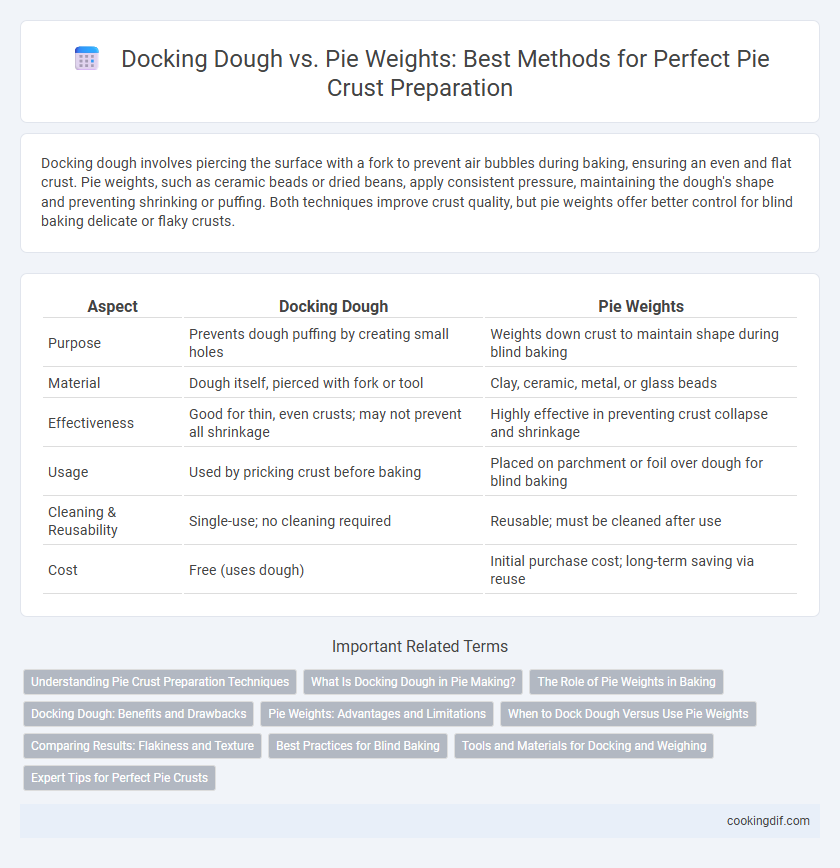Docking dough involves piercing the surface with a fork to prevent air bubbles during baking, ensuring an even and flat crust. Pie weights, such as ceramic beads or dried beans, apply consistent pressure, maintaining the dough's shape and preventing shrinking or puffing. Both techniques improve crust quality, but pie weights offer better control for blind baking delicate or flaky crusts.
Table of Comparison
| Aspect | Docking Dough | Pie Weights |
|---|---|---|
| Purpose | Prevents dough puffing by creating small holes | Weights down crust to maintain shape during blind baking |
| Material | Dough itself, pierced with fork or tool | Clay, ceramic, metal, or glass beads |
| Effectiveness | Good for thin, even crusts; may not prevent all shrinkage | Highly effective in preventing crust collapse and shrinkage |
| Usage | Used by pricking crust before baking | Placed on parchment or foil over dough for blind baking |
| Cleaning & Reusability | Single-use; no cleaning required | Reusable; must be cleaned after use |
| Cost | Free (uses dough) | Initial purchase cost; long-term saving via reuse |
Understanding Pie Crust Preparation Techniques
Docking dough involves piercing the crust with a fork or tool to allow steam to escape, preventing bubbles and ensuring an even bake, while pie weights are used to weigh down the dough during blind baking to maintain its shape and avoid shrinkage. Both techniques are crucial in pie crust preparation, especially for delicate pastries and custard pies where a stable, crisp base is essential. Utilizing docking and pie weights optimizes texture and prevents sogginess, resulting in a professional-quality pie crust.
What Is Docking Dough in Pie Making?
Docking dough in pie making involves pricking the pastry with a fork or docking tool to create small holes that allow steam to escape during baking, preventing the crust from puffing up or forming air pockets. Unlike pie weights, which are physical weights placed on the crust to keep it flat, docking relies on piercing the dough to control expansion. This technique ensures a flat, even crust ideal for both blind baking and filling with wet ingredients.
The Role of Pie Weights in Baking
Pie weights play a crucial role in preventing the dough from puffing up and shrinking during blind baking by evenly distributing heat and weight across the crust. Using docking dough, which involves piercing holes in the crust, allows steam to escape but may not prevent bubbling as effectively as pie weights. Proper use of pie weights ensures a uniformly crisp and flat crust, creating an ideal base for fillings in both sweet and savory pies.
Docking Dough: Benefits and Drawbacks
Docking dough involves puncturing the crust to release steam, preventing bubbles and uneven rising during baking, essential for achieving a uniformly flat pie crust. This technique enhances the crust's texture and appearance but may create tiny holes that can slightly affect the pie's filling retention, especially with runnier fillings. Docking is particularly beneficial for blind baking, ensuring the crust maintains its shape without puffing, but less necessary when using pie weights for drafts control.
Pie Weights: Advantages and Limitations
Pie weights offer precise heat distribution, preventing dough from puffing up and ensuring an evenly baked crust, which is crucial for delicate pastries. Their reusable nature and ability to conform to the pie's shape provide consistent support during blind baking, reducing the risk of shrinkage and air bubbles. However, pie weights might not reach extremely high temperatures needed for certain recipes and require careful handling to avoid uneven pressure or damage to the crust.
When to Dock Dough Versus Use Pie Weights
Docking dough is ideal when baking pie crusts that require steam to escape, such as blind-baking tart shells or delicate crusts, preventing bubbles and uneven rising. Pie weights are preferred for custard or cream pies to maintain a flat, sturdy crust while preventing shrinkage and sogginess during blind baking. Understanding the recipe's moisture content and baking method determines whether docking or pie weights will produce the perfect pie crust texture and structure.
Comparing Results: Flakiness and Texture
Docking dough and using pie weights both prevent soggy pie crusts by allowing steam to escape during blind baking, but the methods impact flakiness and texture differently. Docking creates small perforations that help the crust bake evenly and maintain a drier, crisper texture, enhancing flakiness by preventing bubbles. Pie weights keep the dough flat and promote even heat distribution, resulting in a uniform crust firmness but potentially less layered flakiness compared to docking.
Best Practices for Blind Baking
Docking dough creates small holes that prevent bubbles from forming, allowing steam to escape evenly during blind baking. Using pie weights, such as ceramic beads or dried beans, applies consistent pressure to the crust, maintaining its shape and avoiding shrinkage or puffing. Combining docking with pie weights ensures a crisp, evenly baked crust ideal for custard or cream fillings.
Tools and Materials for Docking and Weighing
Docking dough requires specialized tools such as a dough docker, a handheld roller studded with pins designed to create small holes that prevent air bubbles during baking. Pie weights, typically ceramic beads or metal balls, are essential for blind baking to maintain dough shape and prevent shrinkage under heat. Both tools ensure optimal crust texture and uniform baking, enhancing the overall quality of pies.
Expert Tips for Perfect Pie Crusts
Docking dough with a fork before baking prevents air bubbles, ensuring an evenly crisp crust by allowing steam to escape. Pie weights, such as ceramic beads or dried beans, apply even pressure on the dough, preventing shrinkage and maintaining the crust's shape during blind baking. Combining both techniques results in a uniformly baked, flaky pie crust with a professional finish.
Docking dough vs pie weights for crust preparation Infographic

 cookingdif.com
cookingdif.com